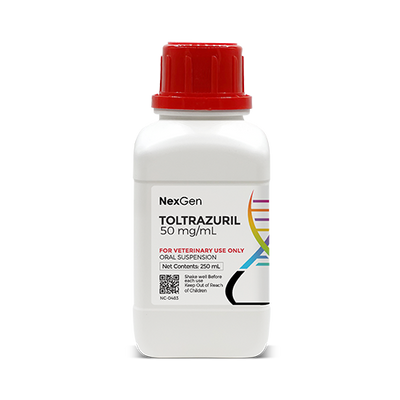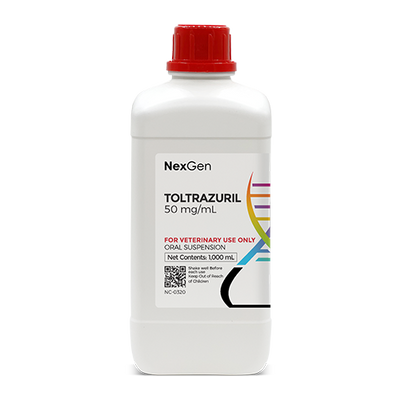
Toltrazuril 75 mg/mL + Folic Acid 5 mg/mL, Oral Suspension, 250mL
Login for pricing
- Brand
- Mixlab
- SKU:
- NC-0322
Equine protozoal myeloencephalitis (EPM) is a disease of the central nervous system caused by the protozoan parasites Sarcocystis neurona and, less frequently, Neospora hughesi. It is a progressive, debilitating disease that can affect any part of the nervous system. EPM is considered the most prevalent cause of neurologic disease of horses in the Americas.
The opossum is the definitive host of S. neurona; its range defines the geographic range of clinical EPM in horses.1Approximately 50% of horses will have antibodies to the S. neurona parasite in their blood in areas where the opossum is common. While seropositivity does indicate exposure, only a small percentage (<1%) of horses will develop clinical disease. Opossums shed infective S. neurona sporocysts in their feces, and horses become infected by ingesting food or water that has been contaminated with the feces. The sporocysts ingested by a horse migrate from the intestinal tract into the bloodstream, crossing the blood/brain barrier and attacking the horse’s central nervous system. EPM can only be transmitted in this manner, therefore one horse cannot directly infect another.
A small percentage of cases of EPM are associated with the protozoal parasite N. hughesi. As with S. neurona-associated exposure, affected horses may not develop clinical signs, or they may show clinical signs consistent with those caused by S. neurona. The life cycle, natural hosts and modes of transmission of N. hughesi are not as well understood as those of S. neurona. Infection with N. hughesi has been associated with abortions, neuromuscular disease and transmission from infected broodmares to their offspring.1
EPM usually occurs sporadically and can only involve one horse on a property. Cases can occur in horses of any age.
EPM: Clinical signs and Diagnosis
Clinical signs of EPM due to S. neurona are generally dependent on the area of the central nervous system attacked by the parasite and the type and degree of damage caused. The onset of EPM may be slow or sudden. Gait abnormalities, incoordination, ataxia, spasticity in the limbs and muscle atrophy can evidence spinal cord involvement, while lethargy, behavioral changes, facial nerve paralysis, tongue paralysis and difficulty swallowing can be the result of brainstem involvement. An infected horse may stand with its feet splayed or lean against supporting structures. Clinical signs may stabilize, only to recur days or weeks later.
A definitive diagnosis of EPM can only be made via postmortem examination of neural tissue.1 Veterinarians typically make a diagnosis of EPM based on:
- A thorough neurologic examination
- Evaluation of serum and/or cerebrospinal fluid (CSF) for the presence of antibodies
- The elimination of other neurological disorders1
Where to buy Toltrazuril + Folic Acid
Toltrazuril + Folic Acid is available in the U.S. through pharmaceutical manufacturers and through veterinary custom compounding companies.
Please consult your veterinarian prior to beginning any treatment regimen.
FOR RX ONLY: A valid prescription from a licensed veterinarian is required for dispensing this medication.
2Furr, M.O., et. al. A 10-day toxicity study of toltrazuril 5% suspension in the horse. Vet Ther. 2000 Fall;1(4):245-51. PMID: 19757571.




















